

| Bibionidae - the St Mark's Flies of Nottinghamshire | ||
| .... | ||
| Often commonly referred to as St Mark's Flies (a term gleaned from the regular appearance of one particular species around St Mark's Day on April 25th each year) the family Bibionidae includes some of the more easily recognised species within our Dipterous fauna. Now 'easily recognised' is something which can rarely be said, as flies are something of a difficult lot and if you've tried to identify a few, you'll have gathered that and probably given up long ago. | ||
| .... | ||
| Patience and persisitence is the key to working
your way through identification keys, keys in which a single hair in the
right or wrong place can often be the determining factor between
different species. If you're impatient and prone to giving up easily because it's
not 'googleable' (which should be a word if it isn't) then studying
Diptera is not the field of entomology for you. However. Over the years most will have driven around the Nottinghamshire countryside and on a warm Spring day, may well have noticed literally hundreds of large black flies with long legs trailing below them, as they swarm and hover over roadside hedgerows, trees, bushes and woodland edges. Lumped together as a group, these are St Mark's Flies of the Family Bibionidae, which includes just the two Genera of Bibio and Dilophus. These two Genera contain some 18 species and a good number of these have been recorded in Nottinghamshire. From the information and records at hand, just Bibio longipes and Dilophus bispinosus have never knowingly occurred in the county. |
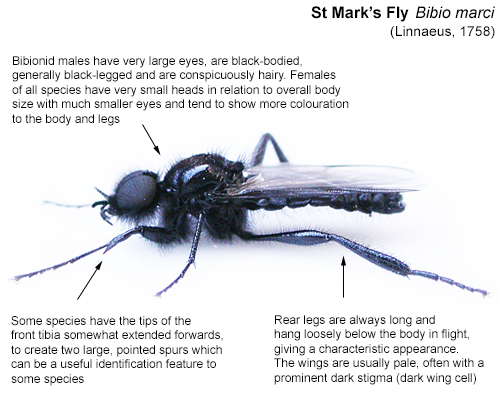 |
|
| .... | ||
| Included here purely as a note of interest, the NBN Atlas incorrectly lists a 1993 record of Bibio varipes from Nottinghamshire, but the record is actually from RAF Wittering a few miles south of Stamford (Lincolnshire) and well away from VC56 Nottinghamshire. But aside from this error, there are no traceable county records of either Bibio longipes or Dilophus bispinosus. |
| .... |
| UK
and Nottinghamshire Bibionidae Of the 18 species of Bibionidae, there are Nottinghamshire records for some 13 species of Bibio (out of 14) and three (out of four) species of Dilophus. Whether the reason almost all possible species have been recorded here lies in the fact that these are obvious and rather distinctive species, is something of an unknown. It is unusual though, especially in regards Nottinghamshire's lack of people willing to undertake serious Diptera study, that so many species within a Family or Genera have been recorded. The list below right, contains all the UK's species. Those species known from Nottinghamshire on the basis of historical records only (presently just the two) are marked with a red asterisk. Species not recorded from the county (two again) are denoted by a blue asterisk. |
|||||||||||
| .... | |||||||||||
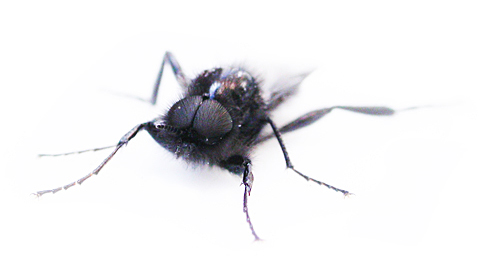 |
|
||||||||||
| .... | |||||||||||
|
Species accounts and recent VC56
records B. anglicus Verrall, 1869 A Bibionid with a predominantly south-easterly UK distribution. Nottinghamshire's only records came during Andy Godfrey's Saproxylic Diptera Survey of Birklands and Bilhaugh SSSI and SAC in 2010, a survey requested on behalf of Natural England. The report lists records from two areas of the Sherwood Forest Country Park. There have been no further records. B. clavipes Meigen, 1818 * Has a scattered UK distribution with records restricted to several well separated areas across England, Wales and Scotland. J.W. Carr lists the following historical records from the county. At Gotham, September 1912 (Robinson) and West Leake, October 1912. From Trowell (Saunt) Lambley Dumble and Papplewick, October 1913 and Nottingham, May 1914. B. ferruginatus (Linnaeus, 1767) Generally scarce with few UK records from a range of counties widely scattered across the UK. There are two historical Nottinghamshire records listed by Carr in his book 'The Invertebrate Fauna of Nottinghamshire. Nottingham: J.& H. Bell Ltd (1916)' and his subsequent suppliment, including a 1913 record from Nottingham and one from Gedling in 1927 (Henderson, G.). There appears to be just a single modern record from Strawberry Hill Heath (Whiteley, D.) in May 1988. |
||
| ... | ||
| B.
hortulanus (Linnaeus, 1758) A
Bibionid of south-eastern parts
of the UK and including some Midlands counties. The NBN Atlas lists no
records for Nottinghamshire, other than records from alongside the
River Maun at King's Clipstone in May 2016
(Pendleton, T.A. and Pendleton, D.T.) and Sherwood Forest CP
in May 2017 (Pendleton, T.A. and
Pendleton, D.T.) which are believed the first for the county.
As with all Bibionidae, there is certainly an element of being somewhat under-recorded in Nottinghamshire, as there are a number of records from neighbouring counties. B. johannis (Linnaeus, 1767) Listed in Carr's book as 'common throughout the county' although it appears through the lack of modern records (even by the poor recording of Diptera in Nottinghamhire) to be much rarer now than it obviously once was. A possible explanation could be that there is an element of over recording of Bibio lanigerus or other small Bibionids, but that does seem rather unlikely and it must surely be overlooked. Having said that, we have recorded the Genera for a number of years, yet have only recently recorded it in early 2021. |
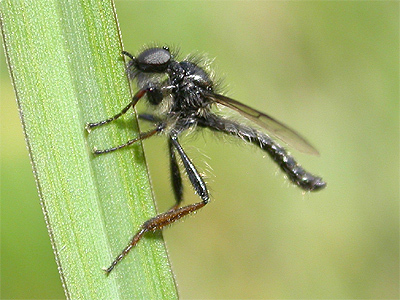 |
|
| ... | ||
|
Modern records of B. johannis are sufficiently rare or
uncommon enough to list individually and include the following
records from 2012 onwards. Netherfield Lagoons 2012
(Netherfield Wildlife Group),
Silverhill Trail April 2016 (Avison, C.),
Toton 2019 (Lygo, B.), Sherwood
Forest CP and near Rainworth Heath NR in April 2021
(Pendleton, T.A.). B. lanigerus Meigen, 1818 Like most of our Bibionidae, this is another under-recorded species throughout the county. Historically, Carr gives records from Winkburn April 1914, Ollerton June 1914 and Mapperley Plains May 1915. Over the intervening century or so, the number of modern B. lanigerus records has increased substantially and it is often the commonest species present at some Sherwood Forest sites. Now common and widespread on those sites lying on sandy soils north of Nottingham, with records from many sites up to and including past the town of Mansfield. |
||
| ... | ||
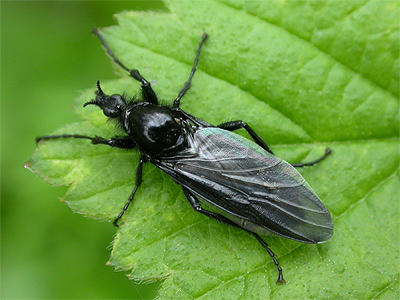 |
B. leucopterus (Meigen, 1804)
Common in many parts of the UK. One of the larger Bibionids but less
common and best seperated from B. marci by the male's milky
white wings (this can be dependant on observer familiarity with the
two species) and having two
spurs at the base of the front tibia of equal length. Modern records
have come from sites as far apart as Netherfield Lagoons
(Netherfield Wildlife Group) and
Dyscarr Wood (Bradford, P.) near
Worksop. It is fairly common in the Sherwood Forest area, but it is
easy to lose the smaller numbers of B. leucopterus among
the masses of B. marci. Carr lists just a handful of
historical Nottinghamshire records, which include Aspley Woods in
May 1912, Sherwood Forest near Ollerton, June 1914 and near Newbound
Mill, Teversall in May 1915. B. marci (Linnaeus, 1758) By far the commonest species of the Genus and found widely across most parts of Nottinghamshire. No doubt considerably under-recorded, yet it will have been seen by the vast majority of the county's population at some time or other. Large numbers are regularly seen flying around Hawthorn, leading to the name Hawthorn Fly. However, it is more commonly referred to as the St Mark's Fly, due to emerging around April 25th (St Mark's Day) each year. Just after the turn of the last century, Carr stated it to be 'common throughout the county' - a status which still applies today. |
|
| ... | ||
|
B. nigriventris Haliday, 1833
As with most Bibionidae, UK records shown on the NBN Atlas tend to
be clustered around certain areas of England, Wales and Scotland, so
it would seem correct to assume that there is (or has been) a degree
of recorder bias, rather than all the UK's species being similarly
restricted in range. The following historical records are listed in Carr's book published in 1916. Worksop (Hodding). Sherwood Forest near Ollerton, June 1914 (Carr, L.A.); Crow Wood Hill, West Leake Hills April 1914 (Thornley and Carr) and Gedling, May 1915. In addition, there are many old Nottinghamshire records listed on the NBN Atlas, from between 1916 and 1920. The only modern records are from the Sherwood Forest CP in April and May 2017 (Pendleton, T.A. and Pendleton, D.T.), Cuckney Hill near Market Warsop May 2020 and Gleadthorpe May 2020 (Pendleton, T.A.). B. pomonae (Fabricius, 1775) Most of the UK's records come from Scotland and Wales, with records becoming less frequent towards south-eastern counties of England. B. pomonae is not mentioned in Carr's original work, but his follow up 'The Invertebrate Fauna of Nottinghamshire. Supplement. (1935) Nottingham: J.& H. Bell Ltd, lists five records between 1917 and 1919. Included in the records Carr lists in his summary for B. pomonae are 'Beauvale Woods July 1917; Bestwood Park June 1918; Budby Carr, Sherwood Forest, July 1919; Cuckney Hay Wood, Nether Langwith, males flying gregariously and in large numbers, July 1925. There are three recent records which are not listed on the NBN Atlas and which is entirely an error on our part. The records include Sherwood Forest CP, 2011 (Joynt, G.), Sherwood Forest CP July 2011 and Budby South Forest July 2011 (Pendleton, T.A. and Pendleton, D.T.). B. reticulatus Loew, 1846 Seemingly recorded new to Nottinghamshire relatively recently, when recorded at Budby South Forest in May 2017 (Musgrove, A.) and with a subsequent record from Hangar Hill Plantation in March 2021 (Pendleton, T.A.). In the UK, this is a rare species, found at a number of sites in the southern-half of the UK. |
||
| ... | ||
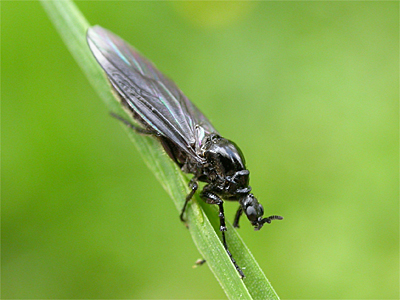 |
B. varipes Meigen, 1830
Found widely across parts of the UK, Bibio
varipes has never been well recorded in
Nottinghamshire, with just two records listed by Carr. These involve
records from South Leverton in May 1896
(Thornley) and Nottngham in May 1914. There are two further
records in Carr's later supplement which lists records from
'Mapperley May 1916 and Wigsley Wood May 1923'. B. varipes remains
something of a rarity in the county, with just two modern records,
from Wellow Park in May 2017 (Pendleton,
T.A. and Pendleton, D.T.) and Netherfield Lagoons in May 2018
(Netherfield Wildlife Group). B. venosus (Meigen, 1804) This is another Bibio found over most of the southern-half of the UK, but with few records. Most records are centred in north and south Wales and parts of The Midlands. Nottinghamshire's historical records include Aspley Woods May 1912; Sherwood Forest near Ollerton, June 1914 and Crow Wood Hill, West Leake in June 1913. The only other county records are a Bilborough record from May 1953 and near Dawgates Wood, Skegby in May 2016 (Avison, C.). D. febrilis (Linnaeus, 1758) Nationally widespread and by far the commonest of the UK's four Dilophus. It is presumed to be much more common in Nottinghamshire than recent records suggest. |
|
| J.W.
Carr describes D. febrilis as being ' generally distributed
and abundant' going on to mention 'in the Spring of 1899, the larvae
caused great damage to the early Lettuces in the Nottingham
district'. Modern records are relatively few, although it is pretty
well recorded compared to most others. Modern day records have come
from a range of habitats and sites between 2008 and 2019. Sites
producing records include Sherwood Heath SSSI, Oak Tree Heath,
Netherfield Lagoons, Sherwood Forest CP, Toton, Meden Vale, Market
Warsop and Calverton. D. femoratus Meigen, 1804 Another common species, found widely across the UK but with notable concentrations of records within parts of Scotland, Wales and The Midlands, although it is found widely over south-eastern counties of England. In Carr's time, D. femoratus was known as D. albipennis, but seems to have been fairly common locally, a century or more ago. Carr lists the following records from 1912. 'Sherwood Forest, about Edwinstowe and Ollerton June; Nottingham in May and July; Aspley Woods May; Radcliffe-on-Trent May; East Leake May and June'. Crow Wood Hill, West Leake May 1918; near Newbound Mill, Teversall May 1915 (Carr). Tollerton May 1918 (Robinson). There are just three modern records, all coming in 2017 from sites lying in the northern-half of Nottinghamshire and which obviously prove D. femoratus is yet another overlooked species. Sites producing records include Sherwood Forest CP in May, Worksop Priory in July and the Idle Valley NR in August 2017 (Pendleton, T.A. and Pendleton, D.T.). D. humeralis Zetterstedt, 1850 Not unduly common in the UK by any means, with a relatively small number of recordscoming from the 'usual' areas where Bibionidae have traditionally been better recorded. Carr lists historical records from Attenborough in July and Bulwell Forest in August 1912, but it has not been recorded in Nottinghamshire since. |
||
| Flies |
| Insects |
| Homepage |
| Contents |